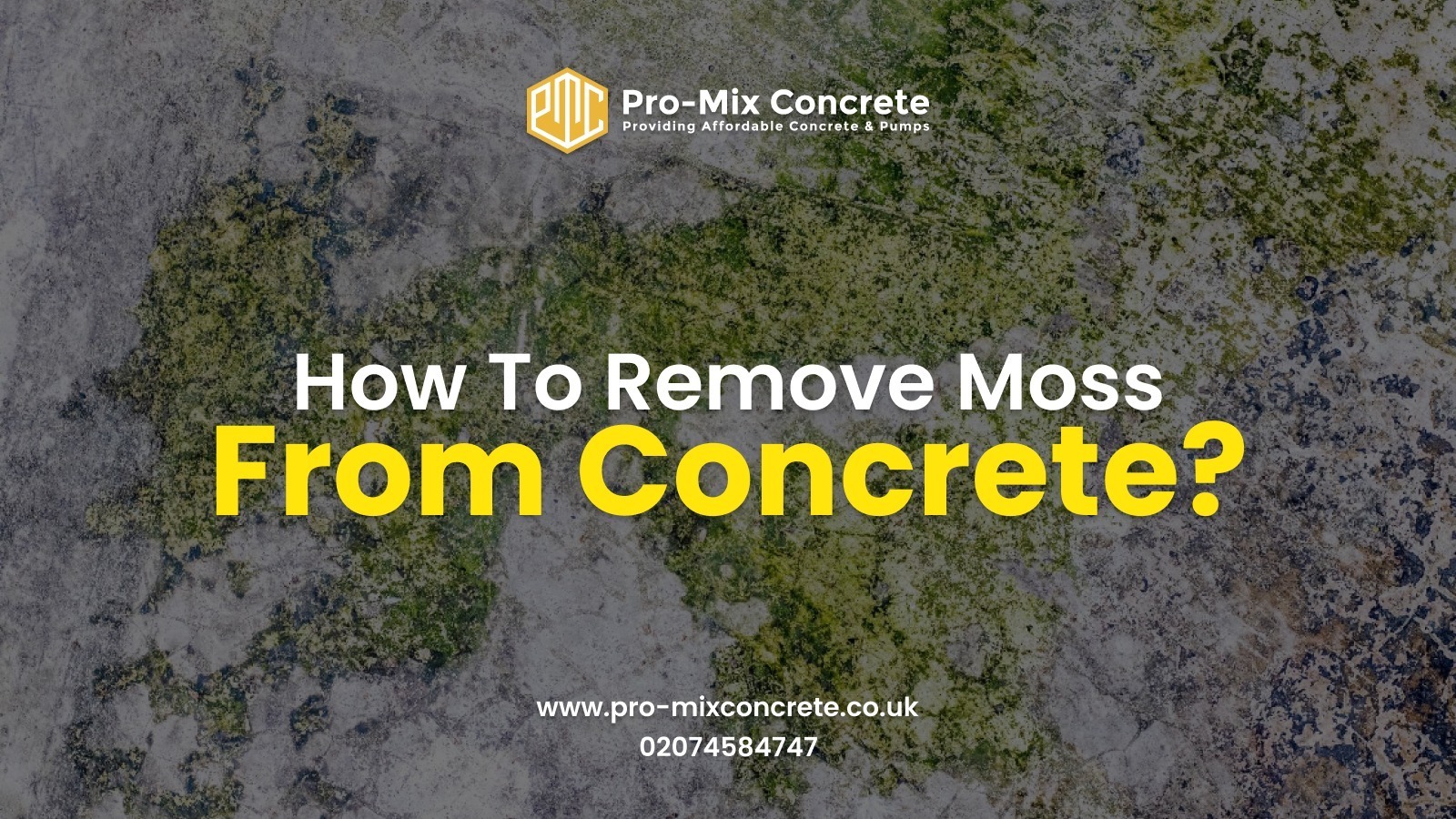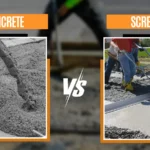If you live in a warm and humid area, you might have a bunch of moss growing around your home, especially on your concrete surfaces like the driveway, sidewalk, or walls. These moss patches look awful, but getting rid of them isn’t too hard. Using basic stuff and methods, we’ll show you how to remove it from concrete.
Moss is a simple, short plant that doesn’t have flowers, and it usually thrives in shady, damp spots. Moreover, some might confuse it with fungi, but moss is different because it has tiny green leaves containing chlorophyll. The plant gets its nutrients and water through these. While it is important for the environment and doesn’t harm people, there are times when we don’t want it on certain surfaces like a concrete patio or on pavers and shingles. Luckily, it’s a breeze to get rid of moss using easy cleaning solutions and techniques.
Read More: How Many Concrete Blocks On A Pallet?
The Conditions That Help Moss Grow
Moss is a simple, nonvascular plant. In other words, it doesn’t have roots. Instead, it uses tiny threads called rhizoids to grip onto your home’s concrete and pavers. These threads grip tight, letting the plant soak up water and grow on the surface. To avoid drying out, moss needs a damp and sheltered place. This wet environment lets water soak in through the rhizoids.
Moreover, concrete and pavers are made of materials with small holes that let the rhizoids anchor where other plants can’t. Certain types of moss also like to grow on surfaces that are a bit acidic. Particular things mixed into concrete can make it more acidic. That’s why you often find moss growing on concrete and paving stones.
Read More: How Much Ballast For 1m3 Concrete?
Can Moss Harm Concrete?
Moss has the potential to harm concrete, mainly because it keeps moisture. Too much moisture can harm various materials, and concrete is no different. Ultimately, having moss around might make your patio or driveway not last as long.
It can move concrete pavers, make cracks bigger, or loosen slabs depending on where it’s growing. Further, it damages the concrete and makes it more dangerous, so it’s a good idea to deal with the issue.
Read More: How is RAAC Concrete Made?
Tools for Removing Moss
When it comes to getting rid of moss, you’ve got a few methods to choose from, and each method requires specific tools. Moreover, here’s what you’ll need depending on your approach:
- Spray Bottle: When using chemicals, you’ll use this to spread the solution onto the moss.
- Rubber Gloves: Safety comes first, as some chemical mixtures can be harsh and unsafe. You better protect your hands with rubber gloves.
- Wire Brush: You’ll need a tough tool like a wire brush to remove rhizoids efficiently. The flexible wires make it easier to clean out cracks in your sidewalk and between pavers.
- Flat-Head Shovel: Moss can get heavy when soaked, and a flat-head shovel makes it easier to remove or lift your hands and back.
- Push Broom: After scraping with the wire brush, use a push broom to sweep away any remaining debris.
- Pressure Washer: The power washer is the ultimate removal machine, coming in handy in various ways.
Read More: Can Artificial Grass Be Placed On Concrete?
Methods for Getting Rid of Moss on Concrete for Good
1. Moss Killer
The most effective way to get rid of moss on concrete is by using a product designed to kill moss, including its spores, to prevent it from coming back. There are various moss killers available, but we suggest using a non-bleach formula. It won’t stain and won’t harm your lawn if you’re working near the grass.
The best time to apply moss killer is early spring, but it works well at any time. It’s most effective when used before the moss becomes a big problem. For optimal results, apply it in dry weather.
How to Apply
- To apply the moss killer, spray it over the entire area and let it sit for at least two hours. During this time, you’ll notice the moss turning yellow.
- After a couple of hours, you can wash away the dead moss using a hose or pressure washer.
- Once you’ve finished hosing down the area, seal any cracks or gaps where moss could hide. This step prevents it from growing back. You can achieve this by applying a “protective sealant” directly to the surface.
- While moss killers should eliminate all the moss, it’s also a good idea to use a protective sealant to guarantee the moss doesn’t return.
Read More: What’s The Difference Between Cement & Concrete?
2. Surface Sanitizer
These hard surface sanitizers are also free from harsh chemicals like bleach, chlorine, phosphorus, and ammonia. This means you won’t be using any harmful substances that could stain or harm the surface.
How to Apply
- Before using a surface sanitizer, see to it that the surface is cool to the touch and free from dirt, grease, or debris. Also, give it a good sweep to make sure it’s clean.
- You can use a brush, roller, or pump sprayer to evenly distribute the sanitizer across the surface. Let it work for 15 minutes to break down the moss.
- Once the moss has turned yellow, you can rinse off the area with water.
- However, rinsing may not be necessary, depending on the type of surface sanitizer you’re using. If something remains, repeat these steps until it’s gone.
While we’ve provided some directions, it’s crucial to carefully read the instructions for hard surface sanitizers. You better protect yourself properly.
Read More: How To Clean Concrete?
3. Baking Soda
Surprisingly, baking soda is a cost-effective and natural way to get rid of moss, and you can easily pick it up at most supermarkets.
How to Apply
When using baking soda on concrete, it’s best to do it on a dry, hot day, not when it’s raining.
- Combine about 10 tablespoons of baking soda with a quart of water for a good mixture.
- Now, give it a good shake before applying it to the surface.
- Once it’s mixed, spray it directly on the moss and the surrounding areas.
- Leave it for 15 minutes, and if necessary, give the area a gentle scrub.
- Once the moss has turned yellow and died, remove it and then clean the surface using a pressure washer or hose until it’s all moss-free and clean.
Read More: How To Make A Concrete Base For Your Shed?
4. Boiling Water
Boiling water is a gentle, chemical-free method to eliminate moss from concrete. Further, this means it’s a great choice, especially if you have plants nearby.
How to Apply
Before starting, ensure the area is free from any obstacles, as they can make removing moss more difficult.
- Take boiling water from a kettle or saucepan with about a one-gallon capacity, being careful not to spill it on your hand when pouring.
- Pour the boiling water over the moss, ensuring it’s completely soaked, and then wait until it turns yellow.
- Once the moss is dead, remove it using your hands.
- After clearing all the moss, wash the area with soapy water and finish up with a pressure washer.
Please note: Boiling water is a simple and effective way to kill moss without using harmful chemicals. However, you may need to repeat the process, as some moss can be tougher to eliminate than others.
Read More: How To Seal Concrete Floor?
5. Concentrated Vinegar
Why would someone use vinegar to get rid of moss? Well, vinegar contains acetic acid, which is an effective moss killer. In fact, vinegar works quite similarly to most commercial moss killers and can do the job in just a few hours.
How to Apply
Just like with bleach, it’s a good idea to dilute the vinegar to prevent any damage to the surface.
- Start with a ratio of 80% vinegar and 20% water. However, a 50:50 vinegar and water mix should work if you’re dealing with lighter moss growth.
- Apply the mixture to the mossy areas and let it sit for at least 20 minutes or until the moss changes colour to yellow.
- If the moss is a bit stubborn, give the surface a scrub as needed.
- Once you’ve removed all the moss, rinse the area with warm water until all the vinegar and moss are gone.
Important: If you have outdoor pets, make sure they don’t access the area until all the vinegar has been completely rinsed off, as it can be harmful if ingested.
Read More: How Much Does A Concrete Block Weigh?
Ending Notes
For more information on how to take care of concrete anywhere around your house, keep visiting Ready Mix Concrete London. We make sure we are on top of these things and help you make your concrete live longer.
Author
- Dennis Broderick
- Dennis Broderick is the founder and owner of Pro-Mix Concrete Company, a trusted name in ready-mix concrete solutions across the UK. With over 20 years of hands-on experience in the construction and concrete industry, Dennis brings unmatched expertise, practical insights, and a commitment to quality on every project - from residential driveways to large-scale commercial developments.
Latest entries
BlogJuly 15, 2025Why Same-Day Concrete Delivery is Vital for Small Builders in London?
BlogJuly 10, 2025Concrete vs. Screed: Which is Best for Your Project?
BlogJuly 5, 20255 Mistakes to Avoid When Ordering Ready Mix Concrete in London
BlogJune 27, 2025How Same-Day Concrete Delivery Works in the UK?




